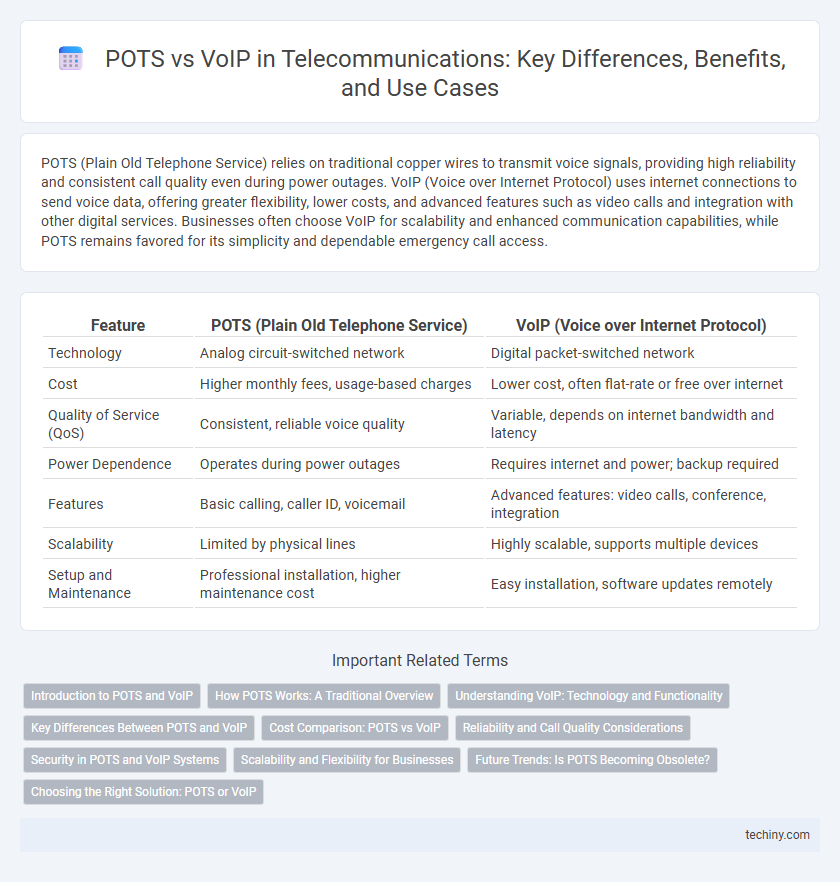POTS (Plain Old Telephone Service) relies on traditional copper wires to transmit voice signals, providing high reliability and consistent call quality even during power outages. VoIP (Voice over Internet Protocol) uses internet connections to send voice data, offering greater flexibility, lower costs, and advanced features such as video calls and integration with other digital services. Businesses often choose VoIP for scalability and enhanced communication capabilities, while POTS remains favored for its simplicity and dependable emergency call access.
Table of Comparison
| Feature | POTS (Plain Old Telephone Service) | VoIP (Voice over Internet Protocol) |
|---|---|---|
| Technology | Analog circuit-switched network | Digital packet-switched network |
| Cost | Higher monthly fees, usage-based charges | Lower cost, often flat-rate or free over internet |
| Quality of Service (QoS) | Consistent, reliable voice quality | Variable, depends on internet bandwidth and latency |
| Power Dependence | Operates during power outages | Requires internet and power; backup required |
| Features | Basic calling, caller ID, voicemail | Advanced features: video calls, conference, integration |
| Scalability | Limited by physical lines | Highly scalable, supports multiple devices |
| Setup and Maintenance | Professional installation, higher maintenance cost | Easy installation, software updates remotely |
Introduction to POTS and VoIP
Plain Old Telephone Service (POTS) is the traditional analog voice communication system utilizing copper wire infrastructure, known for its reliability and simplicity. Voice over Internet Protocol (VoIP) transmits voice data over IP networks, offering scalable, cost-effective, and feature-rich telephony solutions. The transition from POTS to VoIP highlights advancements in digital technology and the shift towards internet-based communication systems.
How POTS Works: A Traditional Overview
POTS (Plain Old Telephone Service) operates through analog signal transmission over copper wire infrastructure, utilizing circuit-switched technology to establish a dedicated communication path between callers. Voice signals are converted into electrical signals and transmitted over a continuous point-to-point connection, ensuring minimal latency and reliable call quality. This traditional system relies on the Public Switched Telephone Network (PSTN) for call routing and switching, supporting basic telephony functions without internet dependency.
Understanding VoIP: Technology and Functionality
Voice over Internet Protocol (VoIP) technology converts analog voice signals into digital data packets transmitted over IP networks, enabling efficient and cost-effective communication. Unlike traditional Plain Old Telephone Service (POTS) that relies on circuit-switched telephone networks, VoIP uses packet-switched networks permitting features such as call forwarding, voicemail to email, and video calls. The underlying functionality leverages protocols like SIP (Session Initiation Protocol) and RTP (Real-Time Transport Protocol) to establish, manage, and deliver voice communication with minimal latency and improved scalability.
Key Differences Between POTS and VoIP
POTS (Plain Old Telephone Service) relies on traditional analog signals transmitted over copper wires, providing a highly reliable but limited feature set focused solely on voice communication. VoIP (Voice over Internet Protocol) uses digital signals sent through the internet, enabling advanced functionalities like video calls, voicemail to email, and integration with other IP-based services. Key differences include cost efficiency, scalability, and flexibility, with VoIP offering reduced operational expenses and enhanced features compared to the fixed infrastructure and maintenance demands of POTS.
Cost Comparison: POTS vs VoIP
VoIP offers significantly lower call costs compared to POTS, especially for long-distance and international calls, due to its internet-based technology minimizing traditional telephony charges. POTS involves higher monthly fees for line rental, maintenance, and connection charges, which VoIP often eliminates or reduces through subscription-based or pay-as-you-go models. Businesses and consumers can achieve substantial cost savings by adopting VoIP, benefiting from flexible pricing plans and reduced infrastructure expenses.
Reliability and Call Quality Considerations
POTS (Plain Old Telephone Service) offers unmatched reliability with its dedicated copper lines, ensuring consistent call quality even during power outages or network congestion. VoIP (Voice over Internet Protocol) depends on internet connectivity, which can introduce variability in call clarity and potential latency issues due to bandwidth fluctuations and packet loss. Businesses often weigh POTS's stable voice transmission against VoIP's cost-effectiveness and advanced features, making network infrastructure and service quality critical factors in decision-making.
Security in POTS and VoIP Systems
POTS (Plain Old Telephone Service) offers inherent security advantages due to its analog circuit-switched network, making it less vulnerable to cyberattacks and hacking compared to VoIP systems. VoIP relies on IP-based networks, exposing it to risks such as eavesdropping, phishing, and denial-of-service attacks unless robust encryption protocols like TLS and SRTP are implemented. Enterprises deploying VoIP must prioritize network security measures, including firewalls and intrusion detection systems, to mitigate the increased cybersecurity threats relative to POTS.
Scalability and Flexibility for Businesses
VoIP offers superior scalability for businesses by easily accommodating additional lines without significant hardware investment, unlike POTS which requires physical infrastructure for each new connection. Flexibility is enhanced in VoIP systems through features like remote access, integration with other digital services, and customizable call routing, providing adaptability to changing business needs. POTS systems lack such dynamic capabilities, making VoIP the preferred choice for growing and evolving enterprises.
Future Trends: Is POTS Becoming Obsolete?
The future of telecommunications is trending heavily toward VoIP technology as it offers enhanced scalability, cost efficiency, and integration with digital services, making traditional POTS systems increasingly obsolete. Industry forecasts predict rapid adoption of VoIP and IP-based communication due to the decline of copper-based infrastructure and the rise of fiber-optic networks. Regulatory shifts and growing consumer demand for multimedia and cloud communication solutions accelerate the transition beyond POTS in both residential and business sectors.
Choosing the Right Solution: POTS or VoIP
Choosing between POTS and VoIP depends on business needs, budget, and infrastructure. POTS offers reliable, traditional voice service with minimal latency and power during outages, making it ideal for emergency use. VoIP provides scalable, cost-effective communication with advanced features like video conferencing and integration with CRM systems, suited for modern, internet-dependent environments.
POTS vs VoIP Infographic

 techiny.com
techiny.com